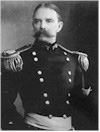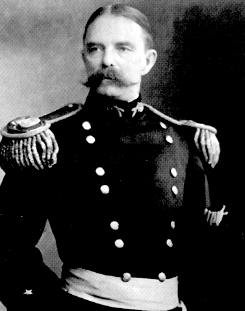The initial Chief of the Aeronautical Division of the Army Signal Corps, the forerunner to the United States Air Force. He was born in Laporte, Indiana, February 13, 1849. He was tapped as “father” of the present-day Air Force on August 1, 1907 when Office Memo Number 6 was issued by the Chief Signal Officer of the Army stating: “An Aeronautical Division of this office is hereby established to take effect on this date. This Division will have charge of all matters pertaining to military ballooning, air machines and all kindred subjects.” He put Captain Charles deF. Chandler in charge of the Division but it operated under him.
An 1872 graduate of West Point, he served in the Cavalry until 1890 when he was transferred to the Signal Corps. In 1898 he sent the first news that Cevera’s fleet was bottled up in Santiago Harbor. He was awarded the Distinguished Service Cross in connectin with this assignment.
He served in Cuba, Puerto, the Philippines, Alaska. He became Chief Signal Officer on February 10, 1906. He authorized the purchase of two balloons, raising to ten the number bought since the Civil War. The Wright Brothers had made their initial flights and there was some pressure for the Army to get into the flying-machinebusiness. But it took him from 1907 to 1911 to get Congressional money in the amount of $125,000 for the first airplanes, and the new Air Service grew slowly.
By February 13, 1913, he reached the age limit of 64 and retired.
He died at Walter Reed Army Hospital, Washington, D.C., on February 19, 1933 and was buried in Section 3 of Arlington National Cemetery.
BRIGADIER GENERAL JAMES ALLEN
Like his predecessor, Adolphus Greely, Chief Signal Officer James Allen (1906-1913) encouraged the technological growth of the Corps.
He not only continued Greely’s aeronautical policies, such as the Signal Corps’ balloon and dirigible operations, but also advocated an air corps, observing in 1909, that other countries were “providing themselves systematically with aerial fleets” and that a sympathetic plan of development of this military auxiliary for the United States should be inaugurated without delay.”
Allen’s early contributions to the Signal Corps included the development of a buzzer-phone that replaced Morse telegraphy in the field and later a field telephone.
He and George Squier (Chief Signal Officer 1917-1923) conducted endless radio experiments and were responsible for the first wireless telegraph link in the Western Hemisphere. Allen’s farsightedness led him to advocate mobile signal equipment in 1906. He observed that equipment was needed to provide “instant communication by the side of the commander, wherever he may be required to go in the exercise of his duties.”
When Allen retired in 1913, he left his successors with new communications technology that would be amply applied on the fields of France in World War I.
Allen, James
- Lieutenant Colonel , U.S. Army
- Home: PaPorte, Indiana
- Chief Signal Officer, U.S. Volunteers
- Date of Action: June 2 – 5, 1898
- General Orders No. No. 14, W.D., 1925
Citation
The Distinguished Service Cross is presented to James Allen, Lieutenant Colonel , U.S. Army, for extraordinary heroism in action at the entrance of the harbor of Santiago , Cuba , June 2 – 5, 1898.
Lieutenant Colonel Allen, by his persistent and untiring efforts on an unarmed transport the Adria, and under fire of the Spanish batteries, succeeded in raising and severing two submarine cables used by the enemy.
Michael Robert Patterson was born in Arlington and is the son of a former officer of the US Army. So it was no wonder that sooner or later his interests drew him to American history and especially to American military history. Many of his articles can be found on renowned portals like the New York Times, Washingtonpost or Wikipedia.
Reviewed by: Michael Howard


